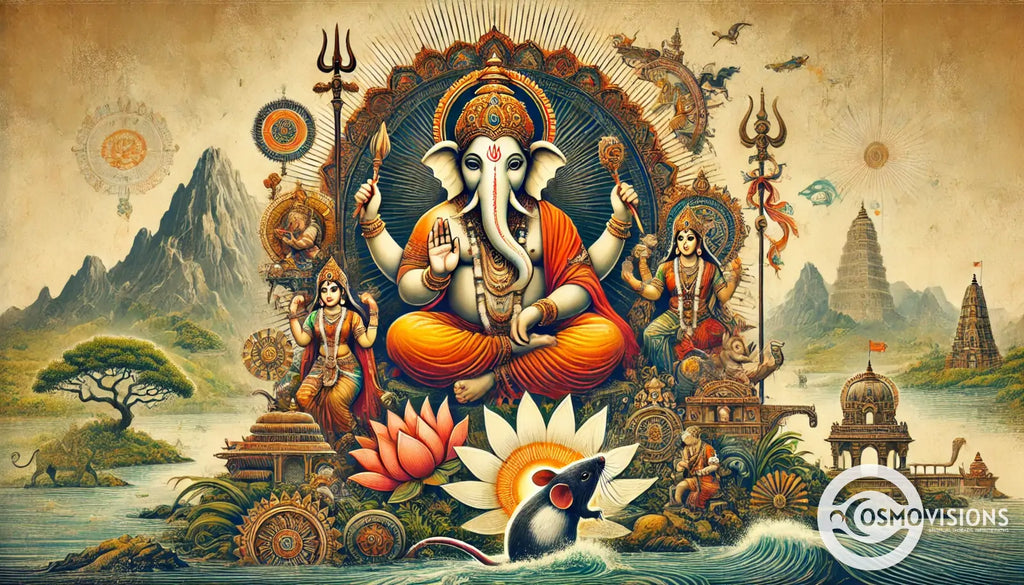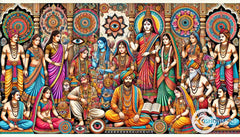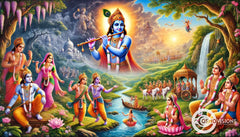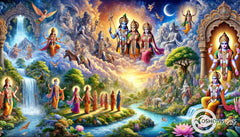Ganesh Story: Lord Ganesha Tales for Kids in English
Posted by Massimiliano Geraci

Searching for enchanting stories about Lord Ganesha that captivate both young minds and the hearts of those who cherish Hindu mythology? Many parents and educators find themselves in this quest, aiming to share the rich tapestry of mythological tales with children, offering them not just entertainment but also a connection to cultural roots and spiritual wisdom.
Lord Ganesha, revered as the remover of obstacles and harbinger of prosperity, stands at the forefront of Hindu deities, embodying lessons of intelligence, humility, and devotion.
Remarkably, among the pantheon of Hindu gods, Ganesha's story is uniquely fascinating – from his birth to how he received his elephant head. This article aims to unravel these ancient narratives in simple English language that appeals directly to kids while holding true to its profound symbolic essence.
By exploring Lord Ganesha's life tales from turmeric paste creation by Goddess Parvati to acquiring an elephant head through divine intervention by Lord Shiva – readers will find themselves on an insightful journey through Hindu mythology.
Discover Ganesh Chaturthi’s significance and learn how families can perform Ganesh Puja at home effectively.
Join us on this adventure!
Who is Lord Ganesha?
Moving from the introductory notions of gods and divine narratives, we now focus on the principal deity, Lord Ganesha. He stands as a pivotal and important deity, in Hinduism, revered widely for his elephant head and human body.
This unique human form captures the imagination of followers and denotes profound symbolic significance within spiritual circles. As the son of Lord Shiva and Goddess Parvati, Ganesha occupies an esteemed position among Hindu deities.
His origin stories are as captivating as they are enlightening, offering insights into themes of creation, resilience, and divine intervention.
Lord Ganesha is known by many titles including Ganapati and Vinayaka, reflecting his myriad qualities such as wisdom, intellect spiritual power, and the ability to remove obstacles. Marked by his large elephant ears that signify listening ability to aid devotees, he sits atop his vahana or vehicle - a small mouse which symbolizes humility despite his mighty form.
Legends like how he obtained his elephant head or why he is worshipped first among gods before any religious ceremony unfolds add layers to understanding cultural practices around him.
Whether it's through festive celebrations like Ganesh Chaturthi or through everyday prayers across homes in India; worshiping Ganesha bridges humanity with divinity fostering an environment where morals from ancient scriptures translate into contemporary learning.

Ganesha: The Hindu God
Ganesha, the Hindu God, holds a significant place in the hearts of devotees around the globe. He is widely recognized by his elephant head, a symbol that merges human intellect with the physical strength of an elephant.
As the son of Shiva and Parvati, Ganesha's tales are rooted deeply in Hindu mythology, embodying wisdom, prosperity, and the removal of obstacles. His image resonates across cultures, not just within Hinduism but also in Buddhism and Jainism.
With myriad forms like Heramba and Ekadanta among others, Ganesha's iconography is rich and varied. He wields symbols like the axe to cut down ignorance and a bowl of modaks representing rewards for wise decisions.
Hindu temples dedicated to him at Ashtavinayaka are prominent pilgrimage sites where devotion meets artistry through intricate sculptures depicting his stories from texts like Ganapati Atharvaśīrṣa and Ganesha Purana.
The Significance of Lord Ganesha
Lord Ganesha holds immense significance in Hinduism, symbolizing the removal of obstacles, wisdom, and intellect. Often depicted with an elephant head, a broken tusk, a big belly, and riding on a tiny mouse, his image transcends the confines of mere iconography into the sphere of cultural and spiritual profundity.
His birth from Parvati's wishes and Shiva's power interweaves mythology with the lesson that even divine entities experience life's challenges through unity and understanding. This deity presides over beginnings, ensuring smooth progress in ventures and learning.
Ganesha clears the path for success.
Worshipped across India on Ganesh Chaturthi—a festival celebrating his rebirth—his idols are crafted from clay to signify connection with earth and creation itself. Families gather to invoke his blessings by offering modaks (sweet dumplings), signifying joyous abundance.
Beyond mere rituals, Ganesha’s stories teach principles of humility against arrogance—as seen when he humbly circled his parents instead of racing around the universe like his brother Kartikeya—to denote respect for one’s roots.
In essence, Lord Ganesha embodies a so many forms a bridge between earthly aspirations and cosmic order.
Lord Shiva and Goddess Parvati's Son
Shiva and Goddess Parvati, residing at their abode on Mount Kailash, desired offspring who would embody both power and wisdom. Their union brought forth Ganesha, a deity with an elephant head and human body, marking him as a unique blend of strength, intelligence, and the auspiciousness necessary to remove obstacles from life's path.
He stands as one of Hinduism's most revered deities, often invoked before any major undertaking to ensure success.
To breathe life into her son Ganesha, Parvati used turmeric paste from her own body, highlighting the deep connection between creation and breathing life into the creator in Hindu mythology. This act symbolizes not merely the birth of their son but also signifies the cycle of life, death, and rebirth that pervades all existence according to Shaivism philosophy.
Following this narrative thread leads us directly into tales that further explore Ganesha’s adventures and teachings.
What Are Some Fascinating Stories About Lord Ganesha?
One of the most captivating tales of Lord Ganesha's birth describes his birth from turmeric paste. Goddess Parvati, desiring companionship while her husband Shiva was away, crafted Ganesha from turmeric paste and breathed life into him.
This act underscores the creative power of the Divine Mother and highlights Ganesha’s role as a protector right from inception. Another intriguing story revolves around how Ganesha acquired his elephant head.
After guarding his mother during her bath, he encountered Shiva who did not recognize him and, in a fierce battle that ensued, decapitated him. Distraught upon learning this was his son, Shiva instructed Nandi to bring back the head of the first animal found facing north, which happened to be an elephant headed god with the head of an elephant himself.
Ganesha's wisdom further shines through in the tale where he outsmarted his brother Kartikeya in a race around the world by simply circumambulating their parents, epitomizing them as his universe.
Each narrative weaves together elements like devotion, wisdom beyond years, and humility - qualities that have endeared Ganesha to followers across millennia. These stories serve not just as religious lore but also offer moral lessons relevant in all walks of life; they bridge generations with themes of respect for parenthood, resourcefulness in adversity, and seeing beyond physical appearances.
Exploring why Ganesh Chaturthi is celebrated brings us deeper into understanding cultural reverence for these narratives within Hindu practice and how this veneration has transcended geographical boundaries over centuries.
The Birth of Hindu God Ganesha from Turmeric Paste
Goddess Parvati, seeking companionship and protection while her husband Lord Shiva was away, crafted a son from turmeric paste she had used for her bath. She infused life into the figure with her divine powers, manifesting Ganesha, who would stand guard at the door as instructed by Parvati.
This act of creation from something as simple yet sacred as turmeric highlights the profound symbolism in Hindu narratives, where materials used in everyday life acquire extraordinary significance through divine intervention.
Tasked with guarding her privacy, Ganesha took his role seriously, stopping even Lord Shiva upon his return. This confrontation between Shiva and the newly born deity marks a pivotal moment leading to further significant events in Hindu mythology including Ganesha receiving an elephant head and becoming widely revered as the remover of obstacles.
Through this narrative, elements such as devotion (bhakti), power (shakti), and transformation are intricately woven together illustrating core principles that guide spiritual practice within Hinduism.
The Story of Ganesha's Elephant Head
Parvati, while bathing, created Ganesha from turmeric paste to guard her door, instructing him not to allow anyone in. Shiva returned and, not recognizing his own son, beheaded him during ensued conflict.
Distraught upon discovering the only boy's head she had crafted was no more, Parvati demanded Shiva bring Ganesha back to life. Complying with Parvati's wishes but unable to find the original ganesha wrapped the little boy his head, Shiva placed an elephant head on the child's body.
This restored life breathed into Ganesha not just vitality but also a new head unique form that elevated his status among deities.
hiva then declared Ganesha the supreme lord who would be worshipped first before any other god and all the other gods thereafter. This decree supports rituals and prayers across Hindu denominations even today. The story exemplifies themes of revival and divine intervention where Lord Shiva’s act, using the elephant goad, transformed Ganesha into a god of beginnings, removing obstacles for souls starting new ventures and liberate Shiva.
The blend of human and elephant features serves as a symbolic integration of wisdom (the large head), humility (the small eyes), and strength (the strong and powerful elephant body).

Ganesha and the Curse of the Moon
Ganesha once stumbled and fell, leading to an unexpected turn of events where the moon found humor in ganesha broke his misfortune. Outraged by the mockery, Ganesha cursed the moon, causing it to disappear from the sky.
This curse was not permanent but brought about a cycle of waxing and waning, symbolizing that pride can lead to one breathing life's downfall. The celestial body begged for forgiveness, prompting Ganesha to modify the curse such that the moon would grow thinner over 15 days before vanishing only to reappear and grow fuller again.
This story serves as a poignant reminder of humility and compassion, essential virtues in both spiritual practice and everyday life. It reveals how even divine entities like Ganesha engage with other celestial figures such as constellations and address conflicts through wisdom rather than wrath divine fury.
Through this tale, worshippers learn about cycles of renewal and redemption — principles that resonate deeply within Hinduism's rich tapestry of mythology and teachings on karma.

Why is Ganesh Chaturthi Celebrated?
Ganesh Chaturthi marks the birth of Lord Ganesha, the son of Shiva and Goddess Parvati, ten day festival celebrated with grandeur across various parts of India. Devotees believe this festival brings wisdom, prosperity, and removes obstacles from their lives.
Traditionally, it involves installing clay idols of Ganesha in homes or public pandals for ten days. Artisans craft these figures with care, embedding symbols like the elephant's head goad (to steer the faithful to the right path) and a small modak (representing reward), reflecting deep-rooted cultural values.
The celebration culminates in Visarjan, where these idols are immersed in water bodies to symbolize a ritual see-off of his journey to Mount Kailash while taking away misfortunes and negatives with him.
This act also underlines themes from Hindu texts encouraging cyclicality and environmental consciousness by using biodegradable materials for idols. During Ganesh Chaturthi, devotees recite Vedas and Puranas tales that emphasize Ganesha’s role as "Vighnaharta", the remover of hurdles.
The festival honors deity worship and fosters community bonding through music, dance, and shared meals among families and communities alike—a true testament to its social significance beyond religious observance.
The History of Ganesh Chaturthi
Ganesh Chaturthi traces its origins to festivities celebrated by the Ganapatya, a sect that revered Ganesha above all deities. This festival brought back the essence of community and devotion through vibrant rituals and artistic expressions.
Historians pinpoint the public observance of this festival to the era of Chatrapati Shivaji Maharaj, aiming to promote culture and nationalism. Yet, it was Lokmanya Tilak who transformed it into a grand public event in 1893, advocating unity against British colonial rule.
The celebration sees devotees across geography bringing idols of Lord Ganesha into homes and public pandals. These idols symbolize God's presence on Earth for ten days before being immersed in water, signifying Ganesha's return journey to Mount Kailash.
The crafting of these idols incorporates elements from social studies about eco-friendly materials - moving from traditional clay to modern alternatives like rice flour or turmeric paste - reflecting an evolving consciousness towards sustainability within religious practices.
Ganesh Chaturthi epitomizes the fusion of devotion with environmental mindfulness.
How Ganpati is Worshipped During the Festival
Devotees initiate the worship of Ganpati during the festival with great zeal, bringing idols of Lord Ganesha to their homes and public pandals. These idols, crafted with immense creativity and reverence, embody the god's presence for the festivities.
Artisans invest months sculpting these figures from environmentally friendly materials, integrating symbolism significant to Hinduism. The process mirrors ancient rituals, reaffirming ties between tradition and communal harmony.
Celebrants carefully decorate these spaces with flowers, fabrics, and lights, creating a vibrant atmosphere that reflects Ganesha’s life-giving power.
The festival features daily prayers known as puja, where offerings such as modaks—believed to be Ganesha’s favorite sweet—and other traditional foods play a central role. Participants chant hymns from sacred texts like the Rigveda and invoke various deities including lord Brahma, and musical Vishnu responded Ganesha himself to solicit blessings for prosperity and obstacle removal.
On the final day, devotees partake in Visarjan—the immersion ceremony—wherein the idol is paraded through streets with music and dance before being submerged in water. This act symbolizes Lord Ganesha's return to Mount Kailash while taking away misfortunes of his followers, underscoring cycles of birth, life, death within Hindu philosophy.
Significance of Ganesha Idols in Ganesh Chaturthi
Transitioning from the diverse ways Ganpati is worshipped during the festival, the importance of Ganesha idols in Ganesh Chaturthi holds a profound place in the hearts of devotees.
These idols, carefully crafted from clay and painted with vibrant hues, embody more than just artistic expression; they serve as a physical representation of Lord Ganesha, inviting his presence into homes and community spaces.
Enshrined with reverence, these figures are central to the rituals performed during this auspicious occasion. They symbolize prosperity, wisdom, and the removal of obstacles—attributes associated with Lord Ganesha.
The immersion (Visarjan) of these idols in bodies of water marks a significant ritual conclusion to Ganesh Chaturthi. This act represents a cycle of birth and rebirth that Lord Ganesha is believed to oversee, reinforcing lessons on impermanence and spiritual renewal among followers.
Through this rite, communities across various cultures engage in shared prayers for enlightenment and grace from hindu deity Vinayaka while fostering bonds within their collective spiritual journey.
Each idol's creation to its immersion encapsulates key elements of devotion (bhakti), tradition (parampara), and continuity (sanatana) inherent in Hindu practices.
How to Perform Ganesh Puja at Home?
Performing Ganesh Puja at home invites prosperity, wisdom, and removes obstacles from one's life. This sacred ritual, deeply rooted in Hindu tradition, requires preparation and a sequence of steps to honor Lord Ganesha.
1. Preparation for Puja: Cleanse the area where you plan to conduct the puja. Ensure it is tidy and free of any clutter. Place an idol or image of Lord Ganesha on a raised platform or altar. Decorate the space with flowers like marigolds and leaves such as mango or betel leaves.
2. Creating a Sacred Atmosphere: Light diyas (lamps) and incense sticks around the altar to purify the environment and create a divine ambiance conducive to spirituality.
3. Invoking Lord Ganesha: Begin by chanting "Om Gan Ganpataye Namah" to invoke Lord Ganesha's presence into the idol or image, asking Him to accept your offerings.
4. Offerings (Naivedya): Prepare offerings for Lord Ganesha, which include modaks (a sweet dumpling considered his favorite), fruits especially bananas, kheer (rice pudding), jaggery, coconut, and greens like durva grass.
5. Panchamrit Abhishekam: Perform Abhishekam by gently pouring a mixture known as Panchamrit (made of milk, curd, honey, ghee, and sugar) over the idol while reciting prayers or mantras dedicated to Ganesha.
6. Shodashopachara Puja: This involves 16 forms of showing honor to Ganesha including welcome gesture (Avahana), offering water for washing His feet (Padya), giving water for sipping and bathing (Achamaniya and Snanam), clothing (Vastram), sacred thread adornment (Upavita), anointing with sandalwood paste (Gandha), offering flowers especially lotus blossoms, incense burning (Dhoop), lighting lamps (Deepa), offering food items specially prepared for puja (Naivedyam), performing circumambulation rounds(Aarti) etc.
7. Prayers and Aartis: Recite specific prayers such as the Vakratunda Mahakaya mantra and perform Aarti for Lord Ganesha using a camphor lamp which should be rotated in front of the deity in a clockwise direction amidst chanting His names.
8. Reading Stories of Lord Ganesha: Narrate interesting stories of Lord Ganesha highlighting his wisdom, humility, and teachings can be an integral part of puja which instills values in participants.
9. Seeking Blessings: Offer your personal prayers asking for wisdom, protection from obstacles, and success in endeavors according to one's wishes and Parvati’s blessings through her son Lord Ganesha.
10. Visarjan (If performing with physical idol): Some families opt for the visarjan ceremony post-puja wherein the idol is immersed in water symbolizing sending off Lord Ganesha back to Mount Kailash joining Shiva and Goddess Parvati ensuring he takes along with him misfortunes of devotees leaving behind blessings.
This structured approach allows individuals to both pay homage and connect deeply with spiritual dimensions, seeking divine guidance from Lord Ganesha - Patronage god of arts and sciences following Vedic traditions across Hindu temples worldwide bringing.
Preparation for Ganesh Puja
Preparing for Ganesh Puja involves a series of steps aimed at creating a sacred and inviting environment for the deity. This ritual, rich in symbolism and tradition, allows devotees to connect with Lord Ganesha on a spiritual level.
1. Select an auspicious date and time, often determined by consulting the lunar calendar, to align the ceremony with cosmic energies.
2. Cleanse the puja area thoroughly to ensure purity and remove any negative energies.
3. Create or obtain an idol of Lord Ganesha, symbolizing his presence during the puja. The idol can be made from clay or turmeric paste, adhering to ancient practices that honor eco-friendly traditions.
4. Place the idol on a raised platform or altar in the northeast corner of the home, which is considered most auspicious according to Vastu Shastra.
5. Decorate the altar with flowers like marigolds and jasmine, which are beloved by Lord Ganesha, for their vibrant colors and fragrances serve as offerings that attract divine energy.
6. Prepare offerings (naivedya) such as modaks and fruits; modaks being a favorite delicacy of Ganesha symbolize joy and are essential for worship.
7. Collect items for the puja such as rice grains (for prosperity), durva grass (representing purification), sindoor (signifying devotion), and betel leaves (an emblem of freshness and satisfaction).
8. Arrange diyas (oil lamps) around the altar to illuminate the space, signifying enlightenment and knowledge removal of ignorance represented by darkness.
9. Obtain pasha (a symbolic item representing control over one's passions) and tusk (emblematic of wisdom), invoking stories where Ganesha’s wisdom overcomes obstacles.
10. A pot filled with water symbolizes the Muladhara chakra associated with stability is placed near the deity to invite grounding energy into your practice.
Through this diligent preparation process, devotees express their devotion while adhering to age-old traditions that bridge mortal spaces with divine energies encapsulated within Ganesh Puja rites.
Step-by-Step Guide for Ganesh Puja
Performing Ganesh Puja at home invites prosperity and removes obstacles from one’s life. It is a spiritual practice that has been carried out with devotion for centuries, deeply rooted in the customs of Hinduism.
1. Clean the area where you plan to install Lord Ganesha's idol. This symbolizes preparation for welcoming positivity and divinity into your home.
2. Place the idol of Lord Ganesha on a raised platform or altar, ensuring it faces the North or East direction, aligning with Vastu principles for maximizing positive energy flow.
3. Light a lamp (Diya) and incense sticks (Agarbatti) to purify the atmosphere, creating a serene ambiance conducive to worship. The light signifies knowledge and enlightenment, guiding devotees on their spiritual journey.
4. Offer fresh flowers like marigolds or lotus buds, which hold immense significance in Pasha (Hinduism), symbolizing purity, beauty, and the awakening of the inner soul towards God.
5. Chant Sanskrit mantras dedicated to Lord Ganesha to invoke his presence and blessings. Reciting "Om Gan Ganapataye Namah" is thought to enhance one's focus and remove any mental barriers.
6. Present Modaks or sweets as an offering to please Lord Ganesha, who is known for his love for Modaks. This act represents feeding divine energy within our consciousness.
7. The Peafowl feather can be used as a decorative element near the idol or altar, representing beauty in spirituality and connection with nature in Hindu lore.
8. Drizzle a mixture of turmeric paste and water over the idol gently – this ritual purification process cleanses any negative energies and sanctifies your prayers.
9. Circumambulate or walk around the deity three times with deep respect and humility after offerings, embodying physical movement as part of prayer to signify entirety—mind, body, soul devotion.
10. Finally, sit quietly in front of the deity to meditate upon Lord Ganesha's qualities: removing obstacles (Vighna Harta), serving as Patron of Arts (Vidya Dayaka), and being a symbol of intellect and wisdom—seeking internal reflection through divine guidance.
This structured approach honors Lord Ganesha and connects individuals with centuries-old traditions fostering spirituality through disciplined practice amidst modern-day life challenges.
Offerings and Modaks for Lord Ganesha
Offerings made to Lord Ganesha during puja embody reverence, devotion, and acknowledgment of his role as the remover of obstacles. Modaks, considered the favorite sweet of Lord Ganesha, hold a special place among these offerings due to their unique significance and the joy they represent.
1. Preparation of Modaks: Crafted carefully with rice flour or wheat flour shells, these dumplings are filled with a sweet mixture of grated coconut and jaggery. The careful preparation process mirrors the devotee's dedication and love for Ganesha.
2. 21 Modaks Offering: Presenting 21 modaks to Lord Ganesha is a common practice that symbolizes offering wealth and knowledge. This number has spiritual significance in Hindu rituals and is believed to bring good luck and prosperity.
3. Durva Grass: Alongside modaks, blades of Durva grass are offered to Ganesha, representing fidelity, resilience, and purification. This plant holds medicinal values in Ayurveda and symbolizes healing in the physical and spiritual aspects.
4. Coconut Offering: A whole coconut is often broken before the deity as a symbol of ego surrender and humility before Ganesha's wisdom. The act signifies breaking one's attachments to materialistic desires.
5. Red Hibiscus Flowers: Red hibiscus flowers are widely used in Ganesh Puja as they attract divine energy and facilitate meditation and spiritual growth.
6. Banana Leaf Presentation: Food offerings to Lord Ganesha are traditionally placed on banana leaves, signifying simplicity, environmental consciousness, and respect towards nature’s gifts.
7. Ghee Lamp Lighting: A ghee lamp is lit during the puja to symbolize the light of wisdom driving away ignorance; it purifies space visually embodying enlightenment.
8. Sankh (Conch Shell): Blowing a conch shell at the beginning of Puja ritual denotes purity and auspicious beginnings; its sound is said to banish evil spirits.
9. Jaggery Water Ritual: Offering water mixed with jaggery after Modak signifies sweetness spreading into one’s life actions resembling Ganesha's promise for removal of all hurdles.
10. Five Fruits Representation: Five different fruits are offered during Ganesh Puja representing earthly abundance but also each fruit symbolizing an aspect necessary for human growth – knowledge (wisdom), health (strength), wealth (prosperity), freedom (liberation) from vicious cycle karmic cycle visual communication between devotee's aspirations divine promise fulfillment.
By incorporating these offerings into Ganesh Puja rituals, devotees establish a deep connection with Lord Ganesha, reinforcing their faith through spiritual actions guided by centuries-old traditions richly imbued with symbolism respectful acknowledgment divine aspects embodied by Ganesha while fostering personal growth humility understanding universe's vast aspects.
What Lessons Can We Learn from Stories About Lord Ganesha?
Stories about Lord Ganesha unfold rich lessons in wisdom and humility, serving as profound educational tools. Among these tales, the narrative where Ganesha encircles his parents to win a challenge against his brother Lord Kartikeya teaches us the value of seeing the world through a lens of love and understanding.
Ganesha demonstrates that true wisdom involves recognizing the significance of those closest to us over any worldly conquest or wealth known for its huge amount.
Another lesson emerges from when Lord Shiva advised him humbly after Kubera learned humility from an insatiable appetite incident. This story illuminates how greed and pride can blind one's judgment, leading even gods like Kubera to folly.
It encourages readers to practice moderation and contentment, highlighting that satisfaction does not stem from material abundance but through embracing simplicity and gratitude within our lives.
Through engaging with these narratives, individuals cultivate a mindset attuned to ethical living and spiritual growth—cornerstones in the study of anthropology, spirituality, and Indios art.

Ganesha: The Remover of Obstacles
Lord Ganesha plays a pivotal role in Hindu mythology as the Remover of Obstacles. Devotees turn to him with their problems, placing their faith in his power to clear paths and facilitate smooth transitions.
This deity, recognized by his elephant head, embodies wisdom and intellect, making him a symbol of prosperity and success across cultures. He is worshiped at the start of ventures for he ensures progress free from impediments.
Ganesha's tales often underscore lessons on humility and wisdom. One story narrates how Ganesha managed to outsmart his brother Kartikeya in a race around the world by simply circumambulating his parents, Shiva and Parvati, emphasizing that devotion and respect towards one's parents are equivalent to honoring the whole world.
Such narratives serve as spiritual guidance and emphasize familial bonds within Indian art.
In every tale lies wisdom; in every act of Ganesha, an answer to life’s numerous hurdles.
Ganesha's Wisdom and Humility
Ganesha exhibits unparalleled wisdom and humility, traits that elevate him beyond the pantheon of Hindu deities and into the hearts of those who study anthropology, spirituality, and Indios art.
His story unfolds not just through words but through actions that resonate with profound spiritual teachings. Take for example his encounter with Vyasa, where Ganesha agreed to write down the Mahabharata.
This task demanded not only divine knowledge but a deep sense of humility to serve as a scribe for another's words. Through this act, Ganesha became a patron of literature and academics, symbolizing the union between intellectual pursuit and spiritual depth.
His dealings with Kubera further illustrate these virtues. The proud god once invited Ganesha to a feast only to find his own arrogance humbled by Ganesha's appetite, both physical and metaphysical.
Eating all that was laid before him and yet unsatisfied until served humility on behalf of Kubera illustrates Ganesha’s ability to subsume pride under the weight of wisdom. Such narratives are instrumental in teaching about removing obstacles – not through force or power but through understanding their nature and finding creative solutions around them.
For followers across world religions, these stories underscore how intellect combined with empathy leads to enlightenment.






















